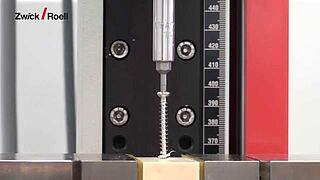Details on bone screw tests
- Testing of bone screws to ASTM F543 refers to four mechanical tests in simplified clinical use. The primary properties involved include torsional strength, insertion and removal behavior, pull-out strength and self-tapping performance of medical bone screws.
- The methods specify a multi-axial test in which a constant preload is applied to the bone screw and a superimposed torsional motion is introduced. The static ZwickRoell testing machines allow easy, operator-friendly implementation of this sequence of motions despite complex control requirements.
- The optional testXpert® Master Test Program, "Evaluation of medical tests," provides automatic, standard-compliant evaluation of the test. These results are used in quality control or technical comparison of individual screw forms.
A1. TEST METHOD FOR DETERMINING THE TORSIONAL PROPERTIES OF METALLIC BONE SCREWS
Description
- Bone screws are aligned via an auxiliary fixture and cast into embedding tubes so that five threads or 20% of the threaded length are exposed.
- Embedding tubes are inserted directly into the testing machine.
- Screw bits are mounted via a quick-acting chuck and the screw is driven at a test speed of 1 to 5 rpm in accordance with the standard. If required, a constant axial preload can be applied.
Result
- Torque versus angle for entire duration of test
- Axial force versus travel for entire duration of test
- Torsional strength
- Maximum torque
- Angle at break
Advantages
- No pre-damage to bone screws through clamping
- Stress-free, centered fixing of bone screws
- Embedding device for simultaneous casting of six bone screws
- Multiple re-use of embedding tube possible
A2. TEST METHOD FOR DRIVING TORQUE OF MEDICAL BONE SCREWS
Description
- Bone screws are inserted into and removed from a test block (may be predrilled); specifications to ASTM F1839; clamping via specimen grips.
- Screw bits are mounted via a quick-acting chuck and the screw is driven at a test speed of 1 to 5 rpm in accordance with the standard. If required, a constant axial preload can be applied.
- A minimum of four screw revolutions are required.
Result
- Insertion/removal torque versus angle for the entire duration of the test
- Axial force versus travel for entire duration of test
Advantages
- Easy test performance and evaluation via testXpert II software
A3. TEST METHOD FOR DETERMINING THE AXIAL PULLOUT STRENGTH OF MEDICAL BONE SCREWS
Description
- Bone screws are driven into a test block (design to ASTM F1839) at an insertion speed of 3 rpm for 20 mm or 60% of the thread length.
- The screw head is pulled out of the test block at a rate of 5 mm/min.
Result
- Axial tensile force versus travel for entire duration of test
- Maximum tensile force
Advantages
- Bone screws are easily inserted into the specimen grip, which is freely accessible from the front
- Self-centering tensile axis
A4. TEST METHOD FOR DETERMINING THE SELF-TAPPING PERFORMANCE OF SELF-TAPPING MEDICAL BONE SCREWS
Description
- The bone screw is driven into a test block at a continuous rotational speed of 30 rpm.
- The axial force is increased by 2.0 N/s during the insertion process until the torque or the axial travel increases significantly.
- The axial force attained at the "biting point" is then maintained and a minimum of five screw revolutions are completed.
- If the bone-screw does not bite after at least five revolutions a further increase of the axial force at 2.0 N/s is permitted.
- The procedure is then repeated from the new "biting point" until at least five valid screw revolutions have been completed.
Result
- Insertion torque versus angle for entire duration of test
- Axial force versus travel for entire duration of test
- Axial force required to insert a self-tapping bone screw into a test block
Advantages
- Axial force required to insert a self-tapping bone screw into a test block
- Integrated evaluation via testXpert® II software












